Thomas Wharton's Blog, page 14
June 22, 2012
The Storyknife
yaaruin: “storyknife”
Language: Central Yup'ik
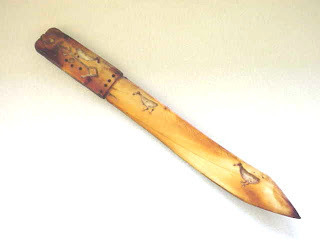
The story knife is a traditional girl’s toy used for sketching pictures on the ground or in the snow. The pictures show clothing, people, houses, animals, and events, and are drawn to illustrate a story or as a game in which others try to guess the artist’s subject. Knife stories were accompanied by songs.
from The Smithsonian Institution’s Alaska Native Collections: http://alaska.si.edu/record.asp?id=222Image from https://www.eed.state.ak.us/productcart/pc/viewPrd.asp?idproduct=3185&idcategory=6

Published on June 22, 2012 06:17
June 20, 2012
Panchatantra
A story from the Panchatantra, the ancient Indian collection of animal fables:
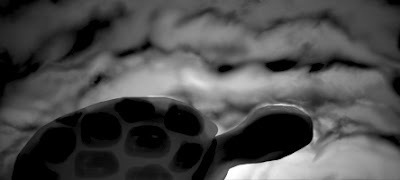
A Tortoise and two Geese lived together in a pond for many years. At last there came a drought and dried up the pond. Then the Geese said to one another, "We must seek a new home quickly, for we cannot live without water. Let us say farewell to the Tortoise and start at once."When the Tortoise heard that they were going, he trembled with fear, and besought them by their friendship not to desert him."Alas," the Geese replied, there is no help for it. If we stay here, we shall all three die, and we cannot take you with us, for you cannot fly."Still the Tortoise begged so hard not to be left behind that the Geese finally said,"Dear Friend, if you will promise not to speak a word on the journey, we will take you with us. But know beforehand, that if you open your mouth to say one single word, you will be in instant danger of losing your life.""Have no fear," replied the Tortoise, "but that I will be silent until you give me leave to speak again. I would rather never open my mouth again than be left to die alone here in the dried-up pond."So the Geese brought a stout stick and bade the Tortoise grasp it firmly in the middle by his mouth. Then they took hold of either end and flew off with him. They had gone several miles in safety, when their course lay over a village. As the country people saw this curious sight of a Tortoise being carried by two Geese, they began to laugh and cry out, - "Oh, did you ever see such a funny sight in all your life!" And they laughed loud and long.The Tortoise grew more and more indignant. At last he could stand their jeering no longer. "You stupid . . . " he snapped, but before he could say more he had fallen to the ground and was dashed to pieces.
Retold by Maude Barrows Dutton in The Tortoise and the Geese and Other Fables of Bidpai, Houghton Mifflin Company, 1908.
Illustration by T Wharton

Published on June 20, 2012 17:38
June 15, 2012
LIving in art
Some days I feel like my creativity is running low, like a dying battery. My ideas seem weak, or I can’t come up with any ideas in the first place. Nothing inspires me. I just don’t feel like writing. Or blogging, for that matter.
Here’s an exercise I do to give my creativity a jumpstart. I think it’s a good thing for anyone to try, whether you think of yourself as a creative person or not. It’s all about stepping outside one’s usual, routine way of seeing and thinking about the world.
Wherever you are right now, imagine that you’ve stepped into a canvas by your favourite artist. How do you see your world differently, for example, if you look at it through Van Gogh’s eyes? Hiroshige’s? James Jean’s? What leaps out at you? Colours? Textures? Shapes? Do you see things you never really noticed before?
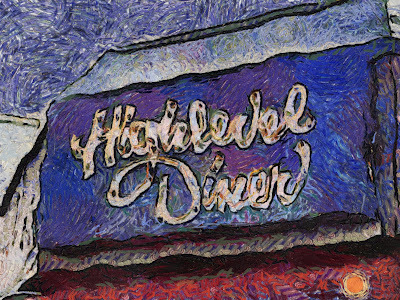
Highlevel Diner seen by Van Gogh, image transformation by AutoPainter Express.
You can do the same thing with music, or poetry, or pretty much any art. If the world around you is a composition by Mozart or Bjork or Miles Davis, what changes? What do you hear? What new rhythms do you notice?
Maybe you’ve stepped into a poem by Mirabai or Emily Dickinson. A short story by Chekhov, or one of Tom Stoppard’s plays. A movie by Kurosawa or Tarkovsky.
If you don’t want to borrow someone else’s aesthetic, imagine this: that you’ve just stepped inside a vast, interactive, unfolding art installation that you are both viewing and creating at the same time. The whole world is a work of art, in space and time, being created right here and now. Washing the dishes as art. Hanging out with your friends as art. Driving down the freeway as art.
Your life as a story or a poem no one has ever read before. A song, a symphony, a fluid, organic, artificial, multimedia, hypertextual ... thing for which there is yet no name.
Well, that’s really what life is anyhow, isn’t it?

Published on June 15, 2012 07:18
June 12, 2012
The clearing
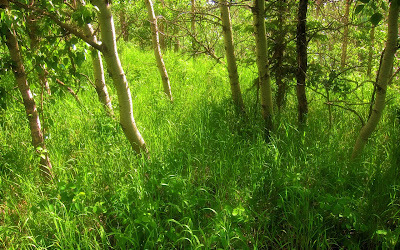
When I was a kid growing up in northern Alberta I heard a story about a magical place: a small clearing in a grove of aspen trees, somewhere among the farms and fields of the district, that had some kind of mysterious power. It was a place that could cure all ills, whether of the body, mind or spirit.
The clearing was rumoured to be on a particular farmer’s land, but if I ever heard the name of the farm family involved, I don’t remember it. I don’t even remember who told me this story.
The story went that the farmer woke up one night without knowing what had disturbed his sleep. He went outside and saw strange white lights glimmering and drifting far off across his land. He thought maybe it was kids with flashlights goofing off, maybe somebody playing a prank. He flicked his own porchlight on and off a few times, to send a message to whoever was out there that he was watching. When that had no effect he went and got his rifle and started walking across his land toward the lights. He hadn’t gone far when the lights suddenly went out.
The farmer, it's important to know, had always been a bitter, angry sort of person, given to bouts of drinking and rage.
The next morning the farmer walked out to where he had seen the lights. It was a grove of trembling aspens between two of his fields. In the middle of the grove was a clearing. Nothing seemed unusual or out of place there. It was a sheltered, peaceful spot of uncut grass and wildflowers. The wind stirred the aspen leaves and they whispered as they always did.
But after the farmer left the clearing, everything had changed. From that day on, much to the wonder and relief of his family, he was cheerful, loving, and content, and never touched another drop of alcohol.
The farmer told his family and a few close friends about what had happened and how he believed it was the clearing that had changed him. He wanted to share the miracle with those he loved and cared about. And so if anyone he told had an illness or a sorrow or a family problem, he took them out to the clearing and left them to spend a little time there, and more often than not the trouble was soon resolved. Even if it wasn’t, the clearing was said to lift a person’s heart and fill you with an unshakeable certainty that all would be well.
The story of course got out, and people used to come out to the farm and pester the farmer to show them to the clearing. He denied any knowledge of what they were talking about and told them they were wasting their time. He had to chase off plenty of curiosity-seekers he found wandering over his fields in search of the “magic spot,” as it came to be known.
That’s pretty much the story as I heard it. Aliens? Angels? I don’t know … to me the tale has the ring of an urban legend. Or I should say, a rural legend. And the details don’t quite add up. If the farmer became so happy and loving, why didn’t he share the miraculous clearing with anyone and everyone who needed it?
Has anyone else heard a story like this, maybe from some other agricultural region of Canada or the world? I’d be interested to know.

Published on June 12, 2012 06:03
June 11, 2012
The LARP people
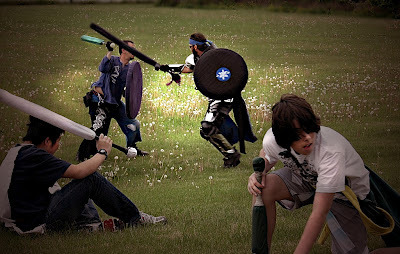
We had seen these live-action role-players many times, playing their games in the field near our house, but we’d never talked to them.
Two summers ago my older son and his friends tried making a sneak attack on the LARP “nerds.” The LARPers smacked them down easily.
Once the younger LARPers attacked me when my running route passed through their realm. But it was a friendly attack. I didn’t feel in the least bit threatened by these screaming medievally-costumed teenagers wielding foam swords and clubs. It was more a territorial display than anything. Or just exuberance.
The next time I ran that way, they didn’t attack. I was strangely disappointed.
Today my younger son and I finally went to the field near my house to watch the LARP people and talk to them.
We talked mostly to Paul, the founder of the group, who came here to Edmonton a few years back. He says that his group, the Western Winds LARP, is the oldest in the city. They are actually not “role-players” in the strict sense of the term, since they concentrate mainly on practicing fighting skills and staging battle games. They don’t develop characters or follow storylines, from what I understood, though other groups in the city do.
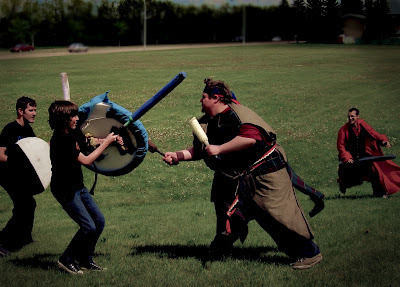 We watched them play a game in which one team had to carry their treasure (a bucket with foam weapons in it) from one side of the field to the other while the other team launched an attack on them and tried to take the treasure. The team with the bucket had the advantage because they had a guy in armour. I mean real armour. Steel breastplate, vambraces, greaves and other stuff I didn’t have a name for. Apparently, in this game, if you’re hit once in an unprotected place, you’re “out” (for a brief time before you can respawn). You have to be hit seven times on an armoured spot before you’re out.
We watched them play a game in which one team had to carry their treasure (a bucket with foam weapons in it) from one side of the field to the other while the other team launched an attack on them and tried to take the treasure. The team with the bucket had the advantage because they had a guy in armour. I mean real armour. Steel breastplate, vambraces, greaves and other stuff I didn’t have a name for. Apparently, in this game, if you’re hit once in an unprotected place, you’re “out” (for a brief time before you can respawn). You have to be hit seven times on an armoured spot before you’re out.It turned out the guy in the armour is a carpenter in his weekday life. On the weekends he’s well-nigh invincible.
It looked like enormous fun. My son wanted to get right in there and join the melee, and truth be told I did, too. We’d like to be LARP people. But my son isn’t old enough yet, and I’m probably too, ahem, mature. And anyhow we didn’t have weapons.
I really liked that armour.
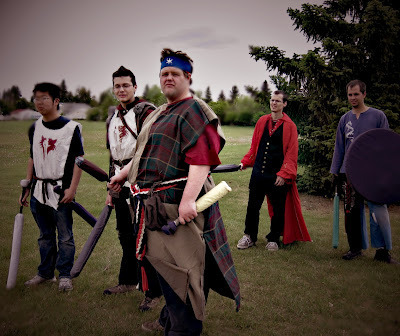

Published on June 11, 2012 06:17
June 6, 2012
Ray Bradbury

“Science is no more than an investigation of a miracle we can never explain, and art is an interpretation of that miracle.”
Ray Bradbury 1920 - 2012
Illustration by T Wharton

Published on June 06, 2012 22:37
June 5, 2012
The wildman
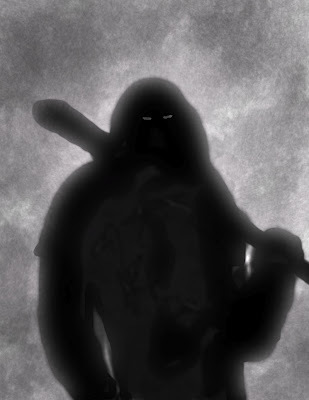
His name is Balor Gruff. He’s nearly seven feet tall. Where he comes from, originally, is unknown. He was found by an Errantry patrol as a baby, abandoned or lost in the forest, and was brought back to Fable, where he was cared for and raised. He was given the last name of Gruff because this was the only sound he made as a baby. As for his first name, one of the Errantry knights thought that this odd-looking creature resembled a dog he’d had a child, named Balor.
It wasn’t clear to anyone what race or species Gruff belonged to, so he was just known by the catch-all term “wildman.” He certainly looked wild enough, with his shaggy hair and a face that has been described as a cross between a lion and an ill-tempered pug dog.
Balor embraced the name of wildman. The alternatives were not to his liking, especially the word “ogre,” which he often hears people whispering in fear as he goes by.
Those who know him well don’t bother about what to call him. What matters to them is that Gruff is a knight of the Errantry, a friend who has proven his courage and loyalty on many occasions. There are times when he can be impulsive, and reckless, but his heart is in the right place.
If there are any other wildman living in the Realm, Balor Gruff has never met any of them, though he would like to, so that he would no longer have to alone in the world. And then he would find out for certain just what, or who, he is.
Image by T Wharton

Published on June 05, 2012 21:00
June 1, 2012
The panther's tale
In my last post I promised to share a story from the Republic of the Animals. Here is one that concerns a panther who strays across the border into the human realm. Notice that if judged by human standards this little fable seems to have no satisfying resolution or lesson.
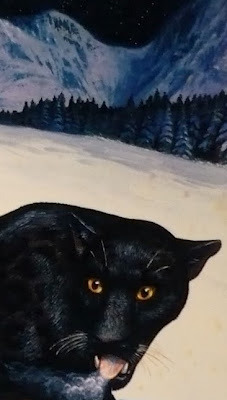
A panther left her jungle home and traveled north, following a river into colder, less forested territory. It was a time of drought, and as she traveled the panther found very few animals to hunt. She was starving to death.
She did not know that in her wanderings she had come to the lands of the humans. She had never seen or heard of humans before.
One evening the panther came upon two crested mynas perched on a dead cedar tree that had been partially rooted up by a bear. The bear was long gone but its scent still lingered.
The mynas were practicing speaking human language. They were eager to get work as translators or envoys between the human and animal realms. In that way they hoped to avoid the fate of most of the animals who strayed near the border in search of food.
A gray langur was perched in another tree nearby. The langur was making fun of the two mynas by imitating their halting speech and laughing at them. The birds were doing their best to ignore the langur.
The panther watched all of this from the concealment of a rhododendron thicket. She watched a beetle crawl up a leaf stem inches from her snout. The beetle stopped. Its feelers waved. Then its wingcase opened and it flew off.
The panther moved then. She stole up on the langur from behind, but hunger had made her desperate and clumsy. The langur heard her coming and escaped, screaming a string of curses at the panther as it clambered away through the treetops.
“Thank you,” the braver of the two mynas said to the panther. “That little [untranslatable] has been taunting us for hours.” “I didn’t do it for you,” the panther said. “Tell me if there’s anything else to hunt around here.”
“Not much,” the myna said. “There’s a place nearby where the humans put their dead in the ground. The bear that dug up this tree looking for insects went there. We warned him not to but he went anyway. He was starving too. He dug up one of the dead humans and ate it. You could try that, too, but be warned: the next evening the bear came back for another body and the humans were waiting with guns and they killed him.”
The panther left the mynas without another word. She did not know what humans or guns were, but the myna’s warning was sincere and she knew she had better be careful.
She found the place where the humans buried their dead. Hiding in the bushes at the edge of the burial ground she could smell a freshly dead body. It was like nothing she had ever smelled before. Eating things she had not killed herself was not in her nature, but surviving was.
As she watched and waited she had a vision of the humans. She saw them in her mind’s eye as impossibly tall and thin creatures, like branches or immense stick insects and they were made of some hard, shiny substance that the light could pass through. The humans had many long, thin, sharp limbs that they were stabbing into the sky and the earth. These limbs must be the guns the mynas had spoken of, the panther thought. The humans were drawing out the golden blood of the sky and the earth into their transparent bodies.
The panther watched the burial ground from her hiding place for a long time. She watched until it was well past dark and then she crept into the burial ground and dug up the fresh corpse and dragged it off to a safe place to eat it. The dead human was small and did not look like the creatures she had seen in her vision. It had died of the drought, the panther knew when she tasted its flesh, which was dry and joyless fare. Yet as she ate it she knew her vision had held some truth. She understood that even if she escaped the bear’s fate this day, the humans would hunt her, sooner or later, and they would kill her.
Towards morning there was a brief fall of rain. The droplets pattered softly on the withered rhododendron leaves. The panther rested after her meal, then she moved on.
Illustration: detail from Walton Ford's "Pantherausbruch"

Published on June 01, 2012 06:22
May 29, 2012
Beast Fable
We are the animals who talk the fablesin which the animals talk. We are talkinganimals, claiming that animals don’t talk.-- Robert Kroetsch
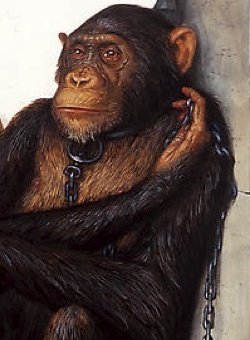
After being forced for so long to play roles in our fables, tales, and myths, the animals at last rebelled.
No longer would they allow themselves to be used to symbolize human qualities (usually negative qualities) or illustrate human ideas. They wanted to live their own lives and inhabit their own stories.
And so, thousands upon thousands of animals left the human stories they had been caged in for so long and made a long and dangerous journey into an unknown, uninhabited region of the Realm that they could call their own.
Many turned back in defeat, many died along the way, but those who persevered founded their own republic, with its own government, laws and society.
Interestingly, there is no “king of the beasts” in the Animal Republic. That was a human notion, the animals assert. Instead, the republic is governed by a council made up of elected representatives from all species.
Just as the city of Fable is the unacknowledged crossroads of the human realm of Story, so the animals have a city where all species may gather and share their tales. A kind of “beast Fable,” one might say.
Humans are not allowed to set foot in the Animal Republic. Any human found there, according to their laws, is fair game for hunting, killing and eating.
There is still some illicit trade, however, between the animal republic and the human world, and one of the items that slips across the border from time to time is Story.
As might be expected, the animals’ own stories are very different from our own. Humans often find them disturbing and inexplicable.
In another post I will share a story from the Animal Republic.
Image: Detail from Walton Ford's painting "A Monster from Guiny" (2007).

Published on May 29, 2012 06:07
May 24, 2012
Ammon Brax
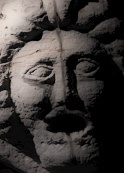
The mountain had been carved in ages past by a forgotten people into the likeness of a great head. A head with eyes staring blindly into the sky and a mouth open in awe or horror or some other emotion that only the long-dead stonecarvers understood.
The young man with jet black hair and a long, sharp-boned face climbed the steep, narrow stair that led to the mouth of the vast head. He carried nothing but a slender walking stick of polished oak.
As he entered the cave of the mouth he opened the wings of his cloak. A pale green light came from the inner lining of the cloak and lit his way through the darkness of the tunnel. Small, skittering creatures fled the light and his footsteps.
He passed several piles of human bones but scarcely gave them a glance. The tunnel branched into many tunnels, and the young man paused for a moment, tilting his head as if listening, before he made his choice and went on.
In a chamber deep inside the mountain he found what he sought. Before him stood a naked giant of a man. Or rather, two halves of a giant man. This was the terrible Zofim, the One Torn in Two.
The two halves of Zofim were busy arguing over the thigh bone of the last treasure-seeker who had dared to enter the giant’s lair. When the young man appeared the two halves dropped the bone and turned their one eye each at the interloper. The two halves of Zofim’s mouth grimaced and slavered. Then both halves of Zofim moved toward the young man.
With one leg apiece you might imagine that Zofim’s halves had to hop awkwardly in order to get anywhere. In fact, over the centuries Zofim’s bony feet had elongated into grotesque handlike extremities, the toes so long and splayed out that they could crawl spiderlike over the stones. The halves of Zofim didn’t hop. They came gliding across the floor, each on one leg, their one foot like a taloned spider upon which they rode.
When they were inches from the young man and towering over him, they stopped and moved closer together. Close enough that their two halves of a face touched and formed one face with a red gash down the middle. This was the only way Zofim’s lips and tongue could form words.
“Did you bring it?” the hideous mouth growled.
The young man nodded. He slipped a small glass vial out of an inner pocket of his glowing cloak. Zofim leaned forward expectantly.
“I hope you remember our bargain,” the young man said. “In exchange for making you whole again, you give me half your treasure.”
Zofim’s bifurcated mouth scowled.
“We remember,” he said.
The young man held out the bottle. Zofim’s two hands grasped for it, pulled out the cork, then poured its thick syrupy contents over his tangled, blood-crusted locks. As the clear fluid ran slowly down the two halves of the giant’s face, neck and chest, it followed the red gash. The fluid traveled the length of his scabbed and filthy frame.
At last it was done. Zofim touched the middle of his face, then his chest tentatively. He strained to pull himself apart, but could not. The red gash still traveled the length of his body, but it was a scar now. The giant was whole. The One Torn in Two was One again.
“And now,” the giant said, grinning, “you die.”
He reached for the young man, but Zofim’s legs refused to move. He looked down, snarling. His feet were stuck to the stones of the chamber.
“The Honey of Binding is a very tricky substance to use safely,” the young man said. “It will make anything one with anything else. I noticed that some of the honey made it all the way down your legs and to the floor. In a few moments you will be One with the mountain itself. You will be flesh merged with stone.”
The giant’s eyes grew wide with terror. He struggled and roared and foamed at the mouth. The young man stood nearby, watching. A short time later the giant was completely still, his eyes staring blindly upward, his mouth open in what was decidedly horror. And rage. And agony.
“Why settle for half the treasure when one could have it all,” the young man said. His voice was calm but hands were shaking and his brow slick with sweat. It had cost him much to hide his fear from the giant.
The young man was an apprentice mage from the island of Kyning Rore, but he had grand dreams. He was determined to become Archmage of the High Council someday, and he knew it would take as much gold as it would actual spellcraft to raise himself to that eminence. Gold opened doors, and bought allies, and silence. Gold was more important than spellcraft, which he had never been the best at anyhow. Even the teacher he looked up to the most, Nicholas Pendrake, had lost faith in him and refused to teach him all he knew.
Once he had found and gathered up the giant’s gold, Ammon Brax returned to the motionless giant for a final farewell.
“It’s time we went our separate ways,” he said. “Some of us, anyhow.”

Published on May 24, 2012 07:07



